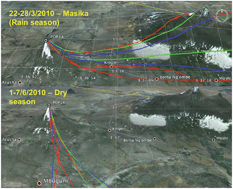Tanzania is an equatorial country characterized by warm temperatures, which should increase the volatilization of persistent organic pollutants (POPs), but this scenario could be different in mountainous areas like Mount Meru, a volcano situated in the East African Rift (Tz). We collected soil samples along an altitudinal transect upto 4577 m a.s.l., reporting the first data about POP contamination in this area (DDX, HCHs, HCB and PCBs). The DDX contamination pattern in Mt. Meru shows levels slightly higher than those of other remote places with a strong increase in the metabolites/DDT historical trend, which is different from DDX, PCBs, HCHs and particularly HCB as this shows very low contamination levels. Back trajectory analysis allowed a discussion about putative contamination sources, while analysis of the environmental features (climatic and pedological) allowed us to discriminate their relative importance. The distribution of POPs shows a strong correlation with soil organic matter and vegetation. SOM-normalization evidenced altitudinal dependence according to cold condensation for PCBs and HCHs, while DDX are present in larger amounts in the agricultural area at the volcano foot. OM-normalized concentrations suggested also a possible role of the OM composition on the POPs’ distribution.

You have access to this article
 Please wait while we load your content...
Something went wrong. Try again?
Please wait while we load your content...
Something went wrong. Try again?


 Please wait while we load your content...
Please wait while we load your content...